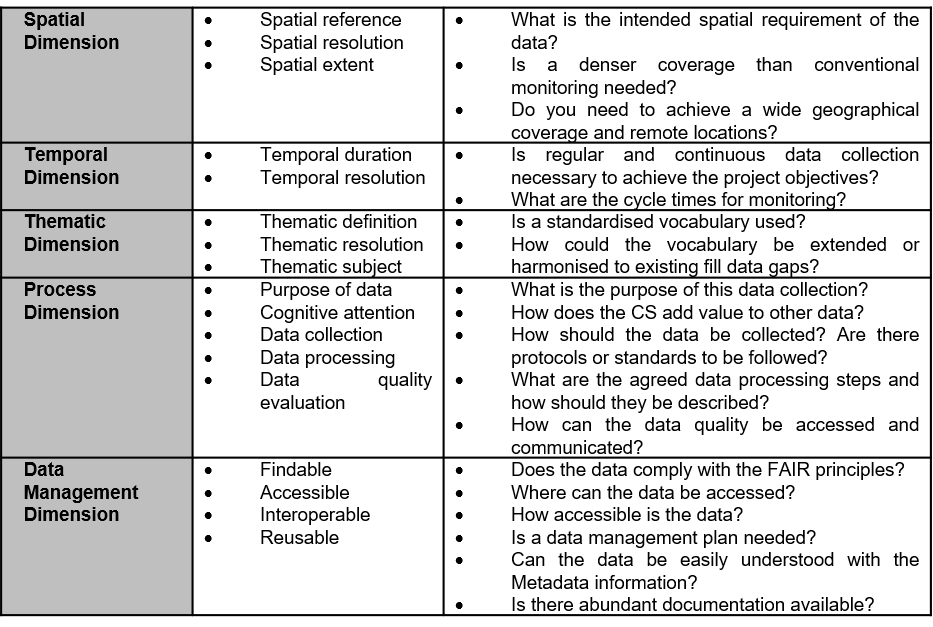Step 1: Setting clear goals and objectives
Setting clear goals and objectives in citizen science projects is essential for their success.

The Workflow to set goals and objectives in citizen science projects is:
The identification of a central research question or problem is essential for the successful conduct of a project. Establishing a well-defined research question that meets the criteria of specificity, relevance, achievability and attainability within the resource and methodological constraints of the project is central to scientific investigation. In this context it is important to ask:
- Apart from the scientists, who else would be interested in the topic? and
- Are the available methods well suited to answer the question and compatible with citizen science?
There are several criteria that needs to be evaluated before a project start (Pettibone et al., 2016):

For a comprehensive assessment of the objectives of a project, the consideration and evaluation of five main dimensions is essential (Fritz et al., 2019).
Questions to be considered to define the purpose of the project:

Measurable outcomes are tangible results or changes that projects aim to achieve through their activities. Identifying measurable, specific and relevant measurable outcomes in citizen science projects is critical to their success. It is important to adhere to guidelines for the identification of results, such as aligning results with the research problem, considering multiple types of results, identifying measurable metrics, involving stakeholders, and maintaining realistic expectations.
The following questions need to be answered:
- What do you want to achieve through this project?
- What are the clear and concrete results decided together with all participants at the begin-ning of the project?
- To facilitate evaluation, can you define measurable outcomes that depend on the success of CS recruitment and retention?
The evaluation of the success of citizen science projects involves the assessment of various criteria in order to determine their impact and effectiveness. Key considerations include scientific results, data quality, engaging participants, engaging the community, and contributing to scientific knowledge.
SMART (Specific, Measurable, Achievable, Relevant, and Time-bound) criteria
- Does your project utilize SMART (Specific, Measurable, Achievable, Relevant, and Time-bound) objec-tives for process tracking and evaluation?
- Are these SMART objectives measurable goals?
- Do you define Key Performance Indicators (KPIs)?
Appropriate goals and objectives
- Are your goals and objectives realistic for effective resource management?
- Do you define achievable tasks, preventing project overwhelm and dropout?
- Are these goals and objective up-hold data quality and scientific rigor?
- Do you think about iterating on what you want to achieve over time in the project?
Prioritisation
- Do you select the most important goals?
- Do you prioritize goals to handle complex tasks?
- Are you considering timely adjustments and continuous improvement to your prioritized goals?
- Do you set clear, understandable goals for communicating effectively?
Intermediate steps
- Do you think that complex tasks are more achievable by decomposing them into objectives?
- Do you break down large goals into smaller, manageable steps?
Feedback and adjustment
- Do you consider regularly reviewing and adjusting goals and objectives by identifying areas for improvement?
- Do you consider stakeholders feedback in changing priorities?
Communication
- Do you believe that the parties involved have a common under-standing and shared responsibility, and do you take this into account in your communication?
- Do you clearly communicate success criteria to all stakeholders?
- Do you have a clear communication plan to meet the expectations and goals of participants, researchers and community members?
It is essential to establish measurable KPIs for assessing the impact of activities. This is important for determining if personal project goals have been achieved and serves as a recognition tool.
When it comes to evaluating citizen science projects, inputs, activities, and outputs are usually easy to measure using quantitative indicators described by KPIs (Schaefer et al., 2021). As an example, Liñán et al. 2022 proposed the following KPIs to measure the achievement of the scientific project goal and its accumulated value at the end of the project: (1) number of observations, (2) number of species, (3) num-ber of observations that have achieved research level, (4) number of participants, (5) number of partici-pants uploading observations and (6) number of volunteers repeating the activity. It is clear that the ben-efits of citizens' involvement can be assessed in terms of easily quantifiable variables such as, among others, the number of participants, hours worked by each participant, the volume of data provided, or the number of publications written based on CS data (Sauermann et al. 2020, Burgess et al., 2017; Sau-ermann and Franzoni, 2015).
Furthermore, KPIs can be introduced to evaluate data quality and reliability by establishing metrics that assess the accuracy, completeness, consistency, and timeliness of provided data. Thus, the defined measures could focus on data completeness and timeliness, such as measuring the percentage of data that is collected within a specific timeframe or the percentage of data that is complete and not missing any required information. By regularly tracking and analyzing these KPIs, project coordinators can gain insights into the quality and reliability of data and identify areas for improvement. This information can be provided to stakeholders and reflects that the data is reliable and can be used confidently.
